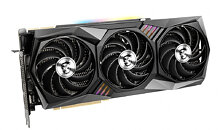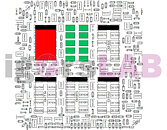Apr 13th, 2025 15:52 EDT
change timezone
Latest GPU Drivers
New Forum Posts
- Dell Latitude 5420 - i7 1185G7 (5)
- What are you playing? (23377)
- Asrock z590 oc formula best cpu and memory speeds? (18)
- should global c-state be "enabled" instead of auto on am5 x3d processors? (25)
- What local LLM-s you use? (154)
- [electronics] - STREAM DECK during gaming? (2)
- Upgrade for a GTX-1060 video card to a X570 AM4 MB w/ a Ryzen 9 3900X (17)
- Optical Disc Drive owners club (198)
- How to relubricate a fan and/or service a troublesome/noisy fan. (216)
- SK hynix A-Die (Overclocking thread) only for RYZEN AM5 users (30)
Popular Reviews
- Thermaltake TR100 Review
- The Last Of Us Part 2 Performance Benchmark Review - 30 GPUs Compared
- TerraMaster F8 SSD Plus Review - Compact and quiet
- ASUS GeForce RTX 5080 TUF OC Review
- Zotac GeForce RTX 5070 Ti Amp Extreme Review
- ASRock Z890 Taichi OCF Review
- Sapphire Radeon RX 9070 XT Pulse Review
- Sapphire Radeon RX 9070 XT Nitro+ Review - Beating NVIDIA
- Upcoming Hardware Launches 2025 (Updated Apr 2025)
- AMD Ryzen 7 9800X3D Review - The Best Gaming Processor
Controversial News Posts
- NVIDIA GeForce RTX 5060 Ti 16 GB SKU Likely Launching at $499, According to Supply Chain Leak (181)
- MSI Doesn't Plan Radeon RX 9000 Series GPUs, Skips AMD RDNA 4 Generation Entirely (146)
- Microsoft Introduces Copilot for Gaming (124)
- NVIDIA Sends MSRP Numbers to Partners: GeForce RTX 5060 Ti 8 GB at $379, RTX 5060 Ti 16 GB at $429 (123)
- Nintendo Confirms That Switch 2 Joy-Cons Will Not Utilize Hall Effect Stick Technology (105)
- Over 200,000 Sold Radeon RX 9070 and RX 9070 XT GPUs? AMD Says No Number was Given (100)
- Nintendo Switch 2 Launches June 5 at $449.99 with New Hardware and Games (99)
- NVIDIA PhysX and Flow Made Fully Open-Source (77)
News Posts matching #MLCC
Return to Keyword BrowsingPrices of Consumer-Spec MLCCs Will Drop Further by 3-6% in 2H22 as Demand Continues to Weaken, Says TrendForce
With the course of the COVID-19 pandemic constantly changing, China is sticking with its "Dynamic Zero-COVID Policy" and has been slow to lift the lockdown on its cities that have been recently affected by the outbreaks of the disease. Hence, the manufacturing industries of the major Chinese cities are facing delays in the resumption of normal operation, and a production gap has emerged in 2Q22. For the electronics ODMs, this production gap will be difficult to bridge in 2H22. Additionally, the ongoing global inflation is keeping prices of goods at a very high level, and this trend will dampen the peak-season demand surge during the second half of the year. The effect of the inflationary pressure has been especially noticeable in the demand for consumer electronics such as smartphones, notebook computers, and tablet computers. This, in turn, is also impacting the MLCC market in terms of demand and inventory. Currently, the general inventory level has risen above 90 days for MLCCs of all sizes. Therefore, TrendForce forecasts that prices of consumer-spec MLCCs will fall further by 3-6% on average in 2H22.
On the other hand, demand remains fairly strong in application segments such as high-performance computing solutions (which include servers), networking equipment, industrial automation solutions, and energy storage systems. Furthermore, IDMs in the semiconductor industry will be adjusting the allocation of production capacity as the market for consumer electronics continues to experience a slowdown in 2H22. As a result, the undersupply situation for certain ICs will ease. Moreover, demand will be propped up in the high-end segment of the MLCC market and other application segments (e.g., automotive electronics and industrial equipment). All in all, thanks to the demand related to automotive electronics, servers, networking equipment, etc., TrendForce forecasts that the annual total MLCC shipments will increase by 2% YoY to around 2.58 trillion pieces for 2022.
On the other hand, demand remains fairly strong in application segments such as high-performance computing solutions (which include servers), networking equipment, industrial automation solutions, and energy storage systems. Furthermore, IDMs in the semiconductor industry will be adjusting the allocation of production capacity as the market for consumer electronics continues to experience a slowdown in 2H22. As a result, the undersupply situation for certain ICs will ease. Moreover, demand will be propped up in the high-end segment of the MLCC market and other application segments (e.g., automotive electronics and industrial equipment). All in all, thanks to the demand related to automotive electronics, servers, networking equipment, etc., TrendForce forecasts that the annual total MLCC shipments will increase by 2% YoY to around 2.58 trillion pieces for 2022.
Taiwan's Passive Component Makers Conservative About Supply and Demand for Q4
After all the reports of component shortages over the past few months, it now seems that the power related problems in China are having an effect on demand of passive components, such as MLCCs (Multilayer Ceramic Capacitor), various types of resistors and inductors among others. As such, manufacturers of said components in Taiwan are cautious about demand for the rest of this quarter, with even big players like Yageo - they're the third largest manufacturer in the world of passive components - being conservative, if somewhat positive about shipments this quarter, according to Digitimes.
As many of the Taiwanese makers of passive components have factories in China, the power cuts in several provinces are adversely affecting these companies. In the case of Yageo, they claim to be able to maintain their production at its largest facility in China, due to it not being located in one of the so far not affected provinces. Some of its competitors aren't as lucky and have already seen losses in production and aren't expecting things to improve. Besides the power outages, there are still issues with the logistics and shipping, which is further causing problems.
As many of the Taiwanese makers of passive components have factories in China, the power cuts in several provinces are adversely affecting these companies. In the case of Yageo, they claim to be able to maintain their production at its largest facility in China, due to it not being located in one of the so far not affected provinces. Some of its competitors aren't as lucky and have already seen losses in production and aren't expecting things to improve. Besides the power outages, there are still issues with the logistics and shipping, which is further causing problems.

MSI Statement Regarding Reported Instability with GeForce RTX 30 Series Graphics Cards
MSI became aware of reports from customers, reviewers, and system integrators that there may be instability when GeForce RTX 30 Series graphics cards core clocks exceeded a certain amount. The latest GeForce driver (456.55) includes fixes for the issue. As such, MSI recommends owners of GeForce RTX 30 Series graphics cards update to the latest driver release which can be downloaded from the NVIDIA GeForce website.
MSI stands behind its design decisions for its GeForce RTX 30 Series graphics cards catalog which consists of GAMING models and VENTUS models. MSI utilizes a mixed capacitor grouping in its designs to benefit from the strengths of both SP-Caps and MLCCs. All MSI GeForce RTX 30 Series cards that have shipped out since the beginning of production, which include media review samples, feature the PCB configurations as shown in the updated images below.
MSI stands behind its design decisions for its GeForce RTX 30 Series graphics cards catalog which consists of GAMING models and VENTUS models. MSI utilizes a mixed capacitor grouping in its designs to benefit from the strengths of both SP-Caps and MLCCs. All MSI GeForce RTX 30 Series cards that have shipped out since the beginning of production, which include media review samples, feature the PCB configurations as shown in the updated images below.

NVIDIA AIC Partners Clarify RTX 3080/3090 Crash to Desktop Issues, Capacitor Choices
(UPDATE 28SEPT 16H31 GMT: Updated the MSI section with changes in the RTX 3080 Gaming X Trio store page).
Compounding the limited availability with the crash to desktop issues users have been experiencing with NVIDIA's recent RTX 3080/3090 graphics cards have led to rivers of digital ink being run on NVIDIA's latest RTX-30 series. After we've reported on NVIDIA's PG132 "Base Design" and manufacturer-specific capacitor choices and circuitry, we've now seen many of NVIDIA's AIC partners actually respond to this issue, clarifying their choices in this specific part of RTX 30-series board design, as well as the steps they've taken (if any) so as to help solve the issues (which are thus confirmed as being somewhat related to these capacitor choices, even if they are not the root cause.)
Compounding the limited availability with the crash to desktop issues users have been experiencing with NVIDIA's recent RTX 3080/3090 graphics cards have led to rivers of digital ink being run on NVIDIA's latest RTX-30 series. After we've reported on NVIDIA's PG132 "Base Design" and manufacturer-specific capacitor choices and circuitry, we've now seen many of NVIDIA's AIC partners actually respond to this issue, clarifying their choices in this specific part of RTX 30-series board design, as well as the steps they've taken (if any) so as to help solve the issues (which are thus confirmed as being somewhat related to these capacitor choices, even if they are not the root cause.)
RTX 3080 Crash to Desktop Problems Likely Connected to AIB-Designed Capacitor Choice
Igor's Lab has posted an interesting investigative article where he advances a possible reason for the recent crash to desktop problems for RTX 3080 owners. For one, Igor mentions how the launch timings were much tighter than usual, with NVIDIA AIB partners having much less time than would be adequate to prepare and thoroughly test their designs. One of the reasons this apparently happened was that NVIDIA released the compatible driver stack much later than usual for AIB partners; this meant that their actual testing and QA for produced RTX 3080 graphics cards was mostly limited to power on and voltage stability testing, other than actual gaming/graphics workload testing, which might have allowed for some less-than-stellar chip samples to be employed on some of the companies' OC products (which, with higher operating frequencies and consequent broadband frequency mixtures, hit the apparent 2 GHz frequency wall that produces the crash to desktop).
Another reason for this, according to Igor, is the actual "reference board" PG132 design, which is used as a reference, "Base Design" for partners to architecture their custom cards around. The thing here is that apparently NVIDIA's BOM left open choices in terms of power cleanup and regulation in the mounted capacitors. The Base Design features six mandatory capacitors for filtering high frequencies on the voltage rails (NVVDD and MSVDD). There are a number of choices for capacitors to be installed here, with varying levels of capability. POSCAPs (Conductive Polymer Tantalum Solid Capacitors) are generally worse than SP-CAPs (Conductive Polymer-Aluminium-Electrolytic-Capacitors) which are superseded in quality by MLCCs (Multilayer Ceramic Chip Capacitor, which have to be deployed in groups). Below is the circuitry arrangement employed below the BGA array where NVIDIA's GA-102 chip is seated, which corresponds to the central area on the back of the PCB.
Another reason for this, according to Igor, is the actual "reference board" PG132 design, which is used as a reference, "Base Design" for partners to architecture their custom cards around. The thing here is that apparently NVIDIA's BOM left open choices in terms of power cleanup and regulation in the mounted capacitors. The Base Design features six mandatory capacitors for filtering high frequencies on the voltage rails (NVVDD and MSVDD). There are a number of choices for capacitors to be installed here, with varying levels of capability. POSCAPs (Conductive Polymer Tantalum Solid Capacitors) are generally worse than SP-CAPs (Conductive Polymer-Aluminium-Electrolytic-Capacitors) which are superseded in quality by MLCCs (Multilayer Ceramic Chip Capacitor, which have to be deployed in groups). Below is the circuitry arrangement employed below the BGA array where NVIDIA's GA-102 chip is seated, which corresponds to the central area on the back of the PCB.
Apr 13th, 2025 15:52 EDT
change timezone
Latest GPU Drivers
New Forum Posts
- Dell Latitude 5420 - i7 1185G7 (5)
- What are you playing? (23377)
- Asrock z590 oc formula best cpu and memory speeds? (18)
- should global c-state be "enabled" instead of auto on am5 x3d processors? (25)
- What local LLM-s you use? (154)
- [electronics] - STREAM DECK during gaming? (2)
- Upgrade for a GTX-1060 video card to a X570 AM4 MB w/ a Ryzen 9 3900X (17)
- Optical Disc Drive owners club (198)
- How to relubricate a fan and/or service a troublesome/noisy fan. (216)
- SK hynix A-Die (Overclocking thread) only for RYZEN AM5 users (30)
Popular Reviews
- Thermaltake TR100 Review
- The Last Of Us Part 2 Performance Benchmark Review - 30 GPUs Compared
- TerraMaster F8 SSD Plus Review - Compact and quiet
- ASUS GeForce RTX 5080 TUF OC Review
- Zotac GeForce RTX 5070 Ti Amp Extreme Review
- ASRock Z890 Taichi OCF Review
- Sapphire Radeon RX 9070 XT Pulse Review
- Sapphire Radeon RX 9070 XT Nitro+ Review - Beating NVIDIA
- Upcoming Hardware Launches 2025 (Updated Apr 2025)
- AMD Ryzen 7 9800X3D Review - The Best Gaming Processor
Controversial News Posts
- NVIDIA GeForce RTX 5060 Ti 16 GB SKU Likely Launching at $499, According to Supply Chain Leak (181)
- MSI Doesn't Plan Radeon RX 9000 Series GPUs, Skips AMD RDNA 4 Generation Entirely (146)
- Microsoft Introduces Copilot for Gaming (124)
- NVIDIA Sends MSRP Numbers to Partners: GeForce RTX 5060 Ti 8 GB at $379, RTX 5060 Ti 16 GB at $429 (123)
- Nintendo Confirms That Switch 2 Joy-Cons Will Not Utilize Hall Effect Stick Technology (105)
- Over 200,000 Sold Radeon RX 9070 and RX 9070 XT GPUs? AMD Says No Number was Given (100)
- Nintendo Switch 2 Launches June 5 at $449.99 with New Hardware and Games (99)
- NVIDIA PhysX and Flow Made Fully Open-Source (77)






